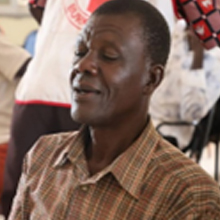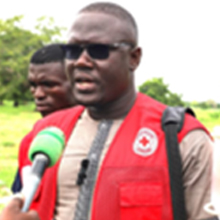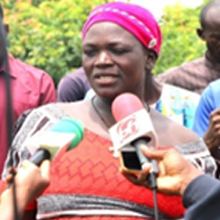Farmers from the Balés region in Burkina Faso, farmers participated in a training session on the installation and use of farmer rain gauges. The session was conducted by teams from the Burkinabe Red Cross (CRBF) and the National Meteorological Agency of Burkina Faso (ANAM). This initiative, mandated by the Hydromet Burkina Faso project, aims to teach the use of this simple tool, and to enable the people trained to benefit their communities.

Farmers posing with their rain gauges in Bingo in the Centre-South. Credit: Burkina Faso Hydromet Project.
STORY HIGHLIGHTS
- Since 2023, the Burkina Faso Hydromet Project has supported the installation of 9,700 farmer rain gauges to help rural communities better manage their crop years.
- With a total $33 million budget, the five-year project aims to improve and make more accessible the hydrometeorological, climate, and early warning services to the targeted communities across the country.
- A total of 9,700 beneficiaries were trained and provided with rain gauges by the Burkinabe Red Cross and the National Meteorological Agency of Burkina Faso. These beneficiaries will serve as liaisons and share knowledge and practices related to these tools with their communities.
It used to be pretty much hit or miss in the village because we would sow our seeds when there was a little rain and, quite often, lose all of them. We wasted time and energy with nothing to show in return in our fields. But thanks to the rain gauge, now we know for sure that we can use the water collected to sow at the right time and get results.

The training sessions conducted throughout the country aim to build community capacity to use meteorological and agrometeorological instruments. The objective is to help communities identify the agroclimatic profile of their province to effectively determine the start and end dates of the rainy season. This method helps determine which inputs are best suited to their specific context. Training sessions have been held in the Central Plateau region of Burkina Faso in Boussé, Ziniaré, and Zorgho, as well as in Gaoua (Poni, Diebougou, Noumbiel, and Ioba), Dedougou Boromo, Manga, and Koudougou.
What role do rain gauges play?
According to the World Meteorological Organization and UNESCO, a rain gauge is an instrument that measures rainfall at a given point. It measures the amount of rain that falls in an area over a period of time.
This activity was a success in each commune because an agricultural worker, a Red Cross volunteer, and a representative from the farmer organizations were trained to serve as liaisons and help farmers install and monitor farmer rain gauges. Plus, the information collected throughout the territory will be transmitted to the National Meteorological Agency to develop a nationwide database.

The Hydromet Project will therefore help improve the reliability of weather forecasts by providing various types of support to the National Meteorological Agency, the General Directorate for Water Resources, and the Early Warning System in the Ministry of Agriculture.
Why target rural communities?
Recorded climate events in Burkina Faso are becoming increasingly unpredictable, frequent, and intense. They have significant impacts on the lives and livelihoods of rural communities, including food and water insecurity risks. The hardest-hit communities are also forcibly displaced by the impacts.
Burkina Faso received financing from the World Bank Group and the Green Climate Fund under the Strengthening Climate Resilience Project (Hydromet) to address this situation. With a total budget of $33 million, the project aims to help beneficiaries adapt their lifestyles and livelihoods to a changing climate to protect themselves against the increasing risk of climate-related disasters.
To improve the delivery of hydrometeorological services to end users, the Burkina Faso Hydromet Project, in collaboration with the National Meteorological Agency, acquired and distributed 9,700 rain gauges to farmers nationwide.
We’ve received farmer rain gauges from the Hydromet Project. They’ll be a big help to us because they measure how much rain has fallen. So we’ll know when to sow and what type of seeds to use to limit losses. Before these rain gauges were available to us, we used to sow randomly and suffered huge losses at harvest time. We are incredibly grateful for the project because it will improve our agricultural operations.

Lastly, a team from the Burkina Faso Hydromet Project Management Unit, accompanied by the national press, spent three weeks traveling across the country to hear from trainers and farmers on their use of the farmer rain gauge and their rainfall data readings. This campaign, which supported the implementation of these activities, helped raise the awareness of many.
